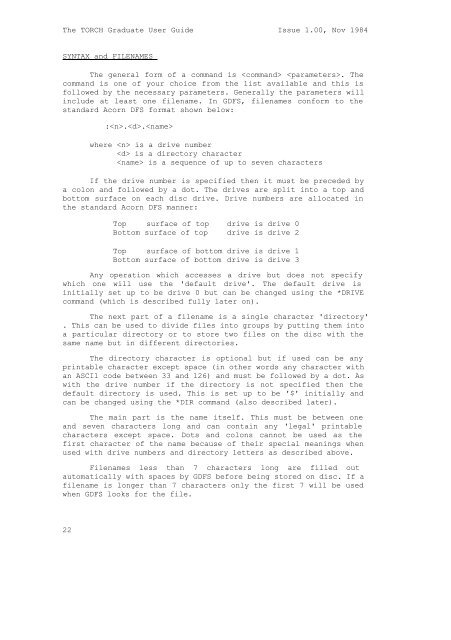The TORCH Graduate User Guide Issue 1.00, Nov 1984 The ...
The TORCH Graduate User Guide Issue 1.00, Nov 1984 The ...
The TORCH Graduate User Guide Issue 1.00, Nov 1984 The ...
You also want an ePaper? Increase the reach of your titles
YUMPU automatically turns print PDFs into web optimized ePapers that Google loves.
<strong>The</strong> <strong>TORCH</strong> <strong>Graduate</strong> <strong>User</strong> <strong>Guide</strong> <strong>Issue</strong> <strong>1.00</strong>, <strong>Nov</strong> <strong>1984</strong><br />
SYNTAX and FILENAMES<br />
<strong>The</strong> general form of a command is . <strong>The</strong><br />
command is one of your choice from the list available and this is<br />
followed by the necessary parameters. Generally the parameters will<br />
include at least one filename. In GDFS, filenames conform to the<br />
standard Acorn DFS format shown below:<br />
:..<br />
where is a drive number<br />
is a directory character<br />
is a sequence of up to seven characters<br />
If the drive number is specified then it must be preceded by<br />
a colon and followed by a dot. <strong>The</strong> drives are split into a top and<br />
bottom surface on each disc drive. Drive numbers are allocated in<br />
the standard Acorn DFS manner:<br />
Top surface of top drive is drive 0<br />
Bottom surface of top drive is drive 2<br />
Top surface of bottom drive is drive 1<br />
Bottom surface of bottom drive is drive 3<br />
Any operation which accesses a drive but does not specify<br />
which one will use the 'default drive'. <strong>The</strong> default drive is<br />
initially set up to be drive 0 but can be changed using the *DRIVE<br />
command (which is described fully later on).<br />
<strong>The</strong> next part of a filename is a single character 'directory'<br />
. This can be used to divide files into groups by putting them into<br />
a particular directory or to store two files on the disc with the<br />
same name but in different directories.<br />
<strong>The</strong> directory character is optional but if used can be any<br />
printable character except space (in other words any character with<br />
an ASCI1 code between 33 and 126) and must be followed by a dot. As<br />
with the drive number if the directory is not specified then the<br />
default directory is used. This is set up to be '$' initially and<br />
can be changed using the *DIR command (also described later).<br />
<strong>The</strong> main part is the name itself. This must be between one<br />
and seven characters long and can contain any 'legal' printable<br />
characters except space. Dots and colons cannot be used as the<br />
first character of the name because of their special meanings when<br />
used with drive numbers and directory letters as described above.<br />
Filenames less than 7 characters long are filled out<br />
automatically with spaces by GDFS before being stored on disc. If a<br />
filename is longer than 7 characters only the first 7 will be used<br />
when GDFS looks for the file.<br />
22
















